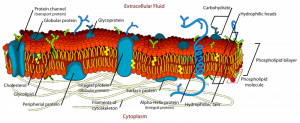 In the mid-1960s I had the honour of working with Professor S. J. Singer on the Fluid Mosaic Model of Biological Membranes for my doctoral thesis. At the time the cell membrane was thought to be a rather static three-layer structure with lipids sandwiched in between protein inner and outer layers. However, we knew that this static 3-layer structure did not fit with the wide range of physical and chemical information that had recently become available on membrane structure.
In the mid-1960s I had the honour of working with Professor S. J. Singer on the Fluid Mosaic Model of Biological Membranes for my doctoral thesis. At the time the cell membrane was thought to be a rather static three-layer structure with lipids sandwiched in between protein inner and outer layers. However, we knew that this static 3-layer structure did not fit with the wide range of physical and chemical information that had recently become available on membrane structure.
The trick was how to reconcile the physical-chemical-electrical properties of biological membranes with some of the thesis data I was collecting on the low rates of flip-flop across membranes of components like glycoproteins and their rather rapid rates of lateral motion in the plane of the membrane. The only way we could fit all of the data into a universal model of cellular membranes was to propose that there were two classes of membrane components, one class that was integral to the membrane and could not be easily separated from the membrane without destroying it and another class that was peripheral and could be removed without loss of membrane integrity. The integral components were proposed to be the asymmetrical phospholipids (phosphatidyl lipids) that naturally form into bilayer ionic barrier structures and proteins and glycoproteins that were also asymmetrical in structure with their lipid-binding and water-hating portions of their structures imbedded deep into the lipid bilayer (some even penetrating entirely across the lipid bilayer) and their lipid-hating and water-binding portions of their structures extending away from the membrane lipids.
 In this way the integral membrane proteins and glycoproteins can literally float in and move laterally in a bilayer sea of fluid phospholipids. What amazed me at the time was how rapid this lateral movement of at least some membrane glycoproteins could be in the membrane plane. Tagging specific membrane glycoproteins with fluorescent markers allowed us to follow in real time the movements of these components relative to the lateral movements of phospholipids, which we knew from electron spin resonance studies were quite rapid.
In this way the integral membrane proteins and glycoproteins can literally float in and move laterally in a bilayer sea of fluid phospholipids. What amazed me at the time was how rapid this lateral movement of at least some membrane glycoproteins could be in the membrane plane. Tagging specific membrane glycoproteins with fluorescent markers allowed us to follow in real time the movements of these components relative to the lateral movements of phospholipids, which we knew from electron spin resonance studies were quite rapid.
However, not all proteins in the membrane move rapidly in the membrane plane, and I later went on to determine that some membrane protein and glycoprotein components were anchored by components inside, or in some cases outside, of the cell. Later some of these were found to be cytoskeletal components inside the cell and extracellular matrix components outside the cell. So some membrane molecules could move rapidly in the plane of the membrane and some were rather fixed in place and unable to freely move.
The basic structure of biological membranes turned out to be the same for the plasma or cell membrane as well as for the various intracellular membranes (nuclear membrane, mitochondrial membrane, etc.). Although each of these intracellular membranes had unique characteristics and components, they all had the same basic characteristics of the Fluid Mosaic Model. For example, take the mitochondria—the energy-generating organelle that produces the ATP needed for cellular functions by the process of oxidative phosphorylation. This organelle is separated from the interior of the cell by a double membrane (inner and outer membranes) barrier, and it has its own unique DNA (mtDNA). The electron transport machinery that generates the ATP from oxygen and fats resides in the inner mitochondrial membrane, and it is completely dependent on the maintenance of a chemical-electrical potential across the inner mitochondrial membrane.
The inner mitochondrial membrane is also one of the most sensitive membranes of the cell to oxidative damage. This is because of its unique membrane structure and the presence of a very oxidation-sensitive phospholipid, cardiolipin. Cardiolipin is functionally required for the electron transport system, and it is synthesised inside the mitochondria from two phosphatidylglyerol molecules, one of the 5 types of phosphatidyl phospholipids that make up biological membranes. When mitochondrial cardiolipin and to a lesser degree other phosphatidyl phospholipids are damaged by oxidation, the chemical/electrical potential across the inner mitochondrial membrane is altered due to an increasingly “leaky” membrane that allows protons and ions to move across the membrane. This occurs because the oxidised membrane phospholipids no longer form a tight ionic/electrical “seal” or barrier. The loss of this ionic/electrical barrier has significant effects on a number of cellular properties, such as loss of electron transport and cellular energy, altered metabolism and even initiation of cell death.
At the level of the organism the loss of mitochondrial function is perceived as loss of overall energy or fatigue. Although fatigue is a complex phenomenon with a number of elements, these elements all depend on mitochondrial energy generation. In experiments that link mitochondrial function with fatigue we have found that mitochondrial function is impaired during injury, disease, inflammation and aging. When fatigue persists for some time, usually at least 6 months, and can’t be refreshed by sleep, it is called chronic fatigue.
In the last few years we have been examining the role that mitochondria play in chronic fatigue and in various chronic illnesses. There are a number of chronic illnesses that are characterised by excessive fatigue, such as the fatiguing illnesses, and these illnesses (chronic fatigue syndrome, myalgic encephalomyelitis, fibromyalgia syndrome, Gulf War illnesses, chronic Lyme disease, among others) all show loss of mitochondrial function. Indeed, essentially all chronic illnesses have associated with them various degrees of fatigue as a major symptom. However, one doesn’t have to have a chronic illness to be affected by fatigue. In fact, it is the most common complaint of all patients seeking general medical care, and it is a natural consequence of aging. It is also present as an important symptom in neurodegenerative, neurobehavioral, metabolic, autoimmune, inflammatory and other diseases.
Fortunately our bodies have a marvellous system to replace the damaged membrane components, especially the oxidation-sensitive membrane phospholipids that contribute to loss of mitochondrial function, fatigue and other alterations of membrane and cellular functions. This system depends on the ingestion and transport of undamaged membrane phospholipids and their precursors to each of our cells via specialised carrier complexes that protect the phospholipids from oxidative damage. Once inside the cell, the undamaged phospholipids and other components of membranes can replace the damaged membrane components. Then the damaged components are degraded and removed from our cells or reutilised after their repair. The problem is that we often do not have good sources of undamaged membrane phospholipids in our diets or even our dietary supplements. Almost all of our dietary and supplement sources of membrane phospholipids also contain oxidised phospholipids that cannot repair mitochondrial damage and restore function.
This is where Lipid Replacement Therapy (LRT®) comes in. This is a natural medicine approach or more specifically a dietary source of undamaged membrane phospholipids, especially the 5 most important phosphatidyl phospholipids that make up biological membranes and provide precursors for specialised phospholipids like cardiolipin.






9 Comments. Leave new
Do you have a few names of those doing this therapy in the US? Any help would be appreciated. Dr Tafel
Hello Dr Tafel
There are a number of clinicians who use NT factor as part of a lipid replacement therapy in the USA. If you contact John Casey [email protected] he will be able to assist.
Best wishes
Michael
If lipid replacement therapy is a “natural medicine”, isn’t it something humans can acquire in their diet? Certainly you can’t be only selling a product here. What foods are you recommending people eat in order to obtain the necessary lipids?
I am curious which NT Factor you recommend? I would like to purchase for my family.
NT factor can be purchased as a powder or blended with other nutrients. Advanced Physician formula is a blend of lipids and B vitamins and minerals and is a well structured daily. ATP Lipids is the trade name of NT factor in its powdered form and is a single nutrient delivery option.
If someone was recently diagnosed with thyroid cancer, which NT Factor would you recommend?
We are not able to make recommendations of this nature, you are best seeking advice from a qualified practitioner.
My husband has gulf war syndrome, can lipid therapy help and how would this help him
Hello Candace, thank you for your enquiry. GWS is an area that Prof. Nicolson has been studying for many years, in particular to explore if the use of specialised lipids may be helpful. Whilst its unlikely the lipids alone will be enough to address all matters they do have an important role. His recent paper will help you understand more about what can be expected.
Nicolson GL, Breeding PC. Membrane Lipid Replacement with glycerolphospholipids slowly reduces self-reported symptom severities in chemically exposed Gulf War veterans. International Journal of Translational Medicine 2022; 2(2): 164-173. https://www.mdpi.com/2673-8937/2/2/14
Michael Ash DO. ND. BSc. RNT
Managing Director